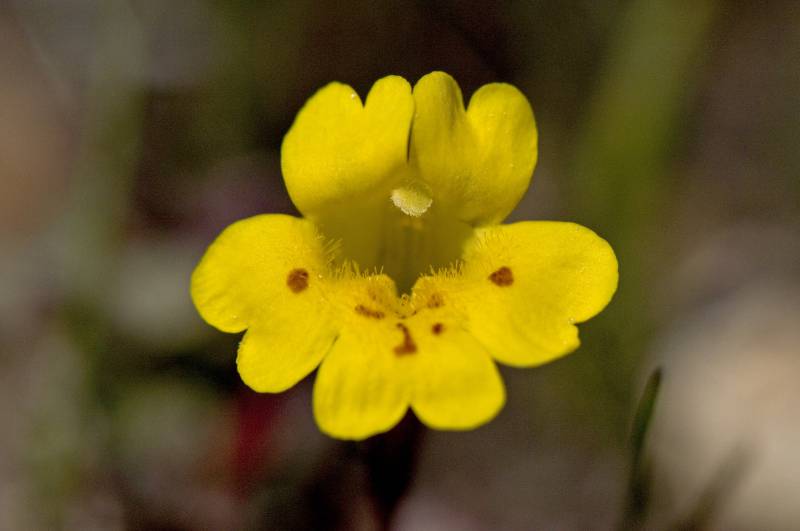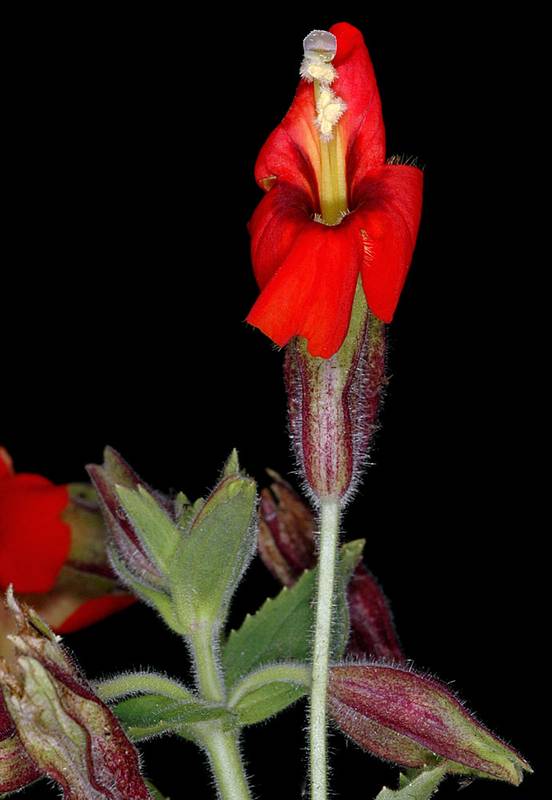Erythranthe primuloides
Erythranthe cardinalis
primrose monkey-flower
scarlet monkey-flower
Leaves opposite, crowded near the ground, short-hairy abaxially (underside), viscid to glabrous adaxially (upperside);
leaves oblanceolate, sessile, nearly entire, 3-nerved from the base, 7-25 mm. long and 3-11 mm. wide.
Leaves typically cauline; sessile;
blade ovate to elliptic to obovate, 20-90 mm long and 10-38 mm broad, palmate venation, base acuminate and nearly clasping, margins irregularly toothed, apex acute, surfaces hairy as stems.
Flowers solitary on slender pedicels up to 10 cm. long arising from the leaf clusters;
calyx narrow, 4-8 mm. long, mostly glabrous, the 5 teeth short, equal;
corolla yellow, often dotted with maroon, 1-2 cm. long, scarcely bilabiate, the 5 lobes spreading, shallowly notched, the throat somewhat flaring;
stamens 4.
Axillary flowers 2-12, emerging from leaf axes at mid- to ends of stem; fruiting pedicels generally 30-90 mm;
calyx cylindric to nearly bell-shaped, not inflated, 17-28 mm, hairy or bristly-hairy, lobes 4-7 mm, ovate to nearly deltate, apex attenuate-acute;
corollas red to orangish red or rarely yellow, throat yellowish with red stripes, palate red, yellow-villous and not spotted or striped, symmetric bilaterally, distinctly bilabiate;
tube-throat funnel-shaped, generally 20-30 mm, protruding beyond calyx margin;
throat open;
styles glabrous;
anthers protruding, white-hairy, thecae spreading.
Capsule.
Capsules 10-16 mm, included.
Erythranthe primuloides
Erythranthe cardinalis
- Local floras:
CA,
OR,
WA
- Local Web sites:
CalFlora,
CalPhotos,
Flora NW,
PNW Herbaria
WildflowerSearch
iNaturalist (observations)
- LBJ Wildflower Center
- SEINet
- Plants of the World Online
- Encyclopedia of Life
- Wikipedia
- Google Image Search
- Local floras:
CA,
OR,
WA
- Local Web sites:
CalFlora,
CalPhotos,
Flora NW,
PNW Herbaria
WildflowerSearch
iNaturalist (observations)
USDA Plants Database
- LBJ Wildflower Center
- SEINet
- Plants of the World Online
- Encyclopedia of Life
- Wikipedia
- Google Image Search



